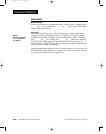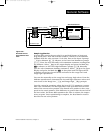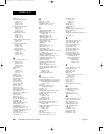
WATLOW Series 988 User’s Manual A.3
Appendix
Glossary, M - Z
linearization, square root — The extraction of a linear
signal from a nonlinear signal corresponding to the mea-
sured flow from a flow transmitter. Also called square root
extraction.
Modbus (RTU) — Remote Terminal Unit.
NEMA 4X — A NEMA specification for determining resis-
tance to moisture infiltration. This rating certifies the con-
troller as washable and corrosion resistant.
on/off — A method of control that turns the output full on
until set point is reached, and then off until the process
error exceeds the hysteresis.
open loop — A control system with no sensory feedback.
output — Control signal action in response to the differ-
ence between set point and process variable.
overshoot — The amount by which a process variable
exceeds the set point before it stabilizes.
P control — Proportioning control.
PD control — Proportioning control with derivative (rate)
action.
PDR control — Proportional derivative control with manu-
al reset, used in fast responding systems where the reset
causes instabilities. With PDR control, an operator can
enter a manual reset value that eliminates droop in the
system.
PI control — Proportioning control with integral (automat-
ic reset) action.
PID — Proportional, integral, derivative. A control mode
with three functions: proportional action dampens the sys-
tem response, integral corrects for droop, and derivative
prevents overshoot and undershoot.
process variable — The parameter that is controlled or
measured. Typical examples are temperature, relative
humidity, pressure, flow, fluid level, events, etc. The high
process variable is the highest value of the process range,
expressed in engineering units. The low process variable is
the lowest value of the process range.
proportional band (PB) — A range in which the propor-
tioning function of the control is active. Expressed in
units, degrees or percent of span. See PID.
proportional control — A control using only the P (pro-
portional) value of PID control.
rate band — A range in which the rate function of a con-
troller is active. Expressed in multiples of the proportional
band. See PID.
ratio — A method by which the controller measures the
flow of an uncontrolled variable and uses a proportion of it
to control the flow of a second variable.
reference junction — See junction.
reset — Control action that automatically eliminates off-
set, or droop, between set point and actual process tem-
perature. Also see integral.
automatic reset — The integral function of a PI
or PID temperature controller that adjusts the process
temperature to the set point after the system stabilizes.
The inverse of integral.
automatic power reset — A feature in latching
limit controls that does not recognize power outage as a
limit condition. When power is restored, the output is re-
energized automatically, as long as the temperature is
within limits.
manual reset — 1) A feature on a limit control
that requires human intervention to return the limit to
normal operation after a limit condition has occurred. 2)
The adjustment of a proportional control to raise the pro-
portional band to compensate for droop.
no key reset — A method for resetting the con-
troller’s memory (for instance, after an EPROM change).
resistance temperature detector (RTD) — A sensor that
uses the resistance temperature characteristic to measure
temperature. There are two basic types of RTDs: the wire
RTD, which is usually made of platinum, and the thermis-
tor, which is made of a semiconductor material. The wire
RTD is a positive temperature coefficient sensor only,
while the thermistor can have either a negative or positive
temperature coefficient.
retransmit output — An analog output signal that may
be scaled to represent the process value or set point value.
RTD — See resistance temperature detector.
slidewire feedback — A method of controlling the position
of a valve. It uses a potentiometer to vary resistance and
indicate position of the valve.
switching sensitivity — In on/off control, the tempera-
ture change necessary to change the output from full on to
full off. See hysteresis.
thermal system — A regulated environment that consists
of a heat source, heat transfer medium or load, sensing
device and a control instrument.
thermocouple (t/c) — A temperature sensing device
made by joining two dissimilar metals. This junction pro-
duces an electrical voltage in proportion to the difference
in temperature between the hot junction (sensing junction)
and the leadwire connection to the instrument (cold junc-
tion).
thermocouple break protection — The ability of a con-
trol to detect a break in the thermocouple circuit and take
a predetermined action.
three-mode control — Proportioning control with integral
(reset) and derivative (rate). Also see PID.
time proportioning control — A method of controlling
power by varying the on/off duty cycle of an output. This
variance is proportional to the difference between the set
point and the actual process temperature.
zero cross — Action that provides output switching only
at or near the zero-voltage crossing points of the ac sine
wave. See burst fire.
zero switching — See zero cross.
C Appendix.wc 5/14/1999 8:33 AM Page A.3


















